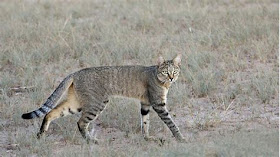While in Zimbabwe in Hwange NP at The Hide, we took a walking safari with a guide and ended up at a spot where all of the guests and guides congregated for a sundowner. A sundowner is where they bring drinks and appetizers and socialize while the sun goes down. They had tables set up in a grassy field with table cloths and chairs set out. As it was getting quite dark, one of the guides shined his flashlight out beyond our get-together a few yards and there were two African wildcats boldly walking side by side very near and parallel to us. It was odd, because, on one hand, it was so brazen, and on the other, they looked like regular house cats that were completely outmatched with no chance for survival in that environment.
I didn't get any photos, so I've borrowed some, as I want to remember the experience. The Southern African wildcat, found in Southern Africa, is one of three subspecies of African wildcat. Another subspecies is found in Kazakhstan, Iran, Afghanistan and western India and the third subspecies is found in West Africa, the Middle East and East Africa.
The body of the wildcat has vertical stripes, but they can vary from very faint to distinct. The tail is rings with black and has a black tip. The chin and throat are white and the chest is paler than the rest of the body. There are two color phases: gray with black and whitish speckling; and tawny/gray with less black and more buff speckling. The ones I saw were of the darker variety, as in the picture above. It looks very much like a house cat we used to have, but the legs are proportionally longer.
They are largely nocturnal and solitary, except when mating and raising their young. It must have been mating season when we saw ours. Their pray includes springhares, which we saw in abundance.


Wow, in daylight photos I am surprised by how much they look like housecats. Very fun to see them in the wild.
ReplyDelete